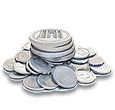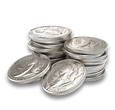How Is the Value of Gold Coins Determined?
- GoldsilverJapan

- Oct 19
- 5 min read
A Complete Guide for Beginners and Investors (Including Goldsilverjapan)
Gold coins have fascinated investors and collectors for centuries. Whether you’re a novice investor or a seasoned numismatist, understanding how the value of gold coins is determined is crucial if you want to buy or sell confidently.
This article breaks down the various factors that influence the value of gold coins—ranging from their gold content and international spot price to collector demand, grading, and historical context. It also introduces Goldsilverjapan, a trusted platform that offers transparent pricing, educational resources, and one of the most competitive buyback systems in the Japanese market.
Let’s dive deep into the fascinating world of gold coin valuation.
✅ What Exactly Is a Gold Coin’s Value?
The value of a gold coin is based on two main pillars:
Intrinsic (Bullion) Value: The value based on the gold content and the current market price of gold.
Collectible (Numismatic) Value: The premium placed on a coin for its rarity, design, historical significance, and condition.
Both elements can influence the final price you pay—or receive—when trading gold coins. Let’s explore each factor in detail.
1. Gold Purity and Weight: The Foundation of Value
Every gold coin has a purity level that indicates how much pure gold it contains.
Common Purity Mark | Meaning |
99.99% or .9999 Fine | Nearly pure gold (24-karat) |
91.67% or .9167 | 22-karat gold (used in American Eagles) |
90% | Often seen in older coins like pre-1933 U.S. coins |
In addition to purity, coins are typically weighed in troy ounces, with 1 oz = 31.1 grams.
To estimate a gold coin’s intrinsic value:
Gold Content × Spot Price = Intrinsic Value
This is your starting point. Everything else (rarity, condition, age) adds numismatic premiums on top of this.
2. The International Spot Price of Gold
The spot price of gold is the real-time price at which gold is being traded globally, usually quoted per ounce in U.S. dollars.
This price fluctuates daily (even hourly) due to:
Inflation and interest rate changes
Geopolitical tensions
U.S. Dollar strength or weakness
Supply and demand for gold
Reliable online dealers like Goldsilverjapan offer real-time pricing on all gold coins based on the current spot price, which ensures transparency for both buyers and sellers.
3. Issuing Country, Year, and Series Popularity
Gold coins are often minted by national governments or central banks. Their reputation can significantly impact value.
Country | Example Coin | Characteristics |
USA | American Eagle | Globally recognized, 22k gold |
Canada | Maple Leaf | 99.99% purity, beautiful design |
Austria | Philharmonic | Widely circulated in Europe |
Japan | Meiji Gold Coins, Emperor Enthronement Commemoratives | High collector interest domestically and internationally |
Older coins or limited-series coins (e.g., Japanese Meiji-era coins) may carry additional collector value beyond their gold content.
4. Rarity and Mintage Volume
Low mintage = Higher value (generally).
Some coins are highly sought after due to:
Low production numbers
Unique design variations
Historical significance
Even modern coins with limited editions (e.g., Proof Gold Eagles) may command significant premiums. Collectors often pay a much higher price for rare coins in good condition.
5. Coin Condition and Grading
Gold coins are graded based on their condition. Better condition = Higher value.
Grade | Meaning |
MS70 | Perfect, flawless condition |
MS69 | Near perfect, only minor imperfections |
AU58 | Almost Uncirculated |
XF (Extra Fine) | Light circulation marks |
VF (Very Fine) | Moderate wear but details visible |
Third-party grading agencies like PCGS and NGC certify coins and assign them a grade. Graded coins are often sealed in plastic holders (slabs), increasing confidence for buyers and sellers.
Goldsilverjapan offers coins listed by grade, and provides pricing that reflects the premium for higher-quality coins. Their platform allows you to view buyback prices in real time, even for graded items.
6. Design, Artistic Appeal, and Historical Significance
Some gold coins are valuable not just for their gold content but also for:
Artistic craftsmanship
Historical stories
Cultural symbolism
Examples include:
The double eagle from the U.S. (St. Gaudens design)
Japanese imperial coins with phoenix or chrysanthemum motifs
Commemorative coins celebrating major events
These attributes may add collector value and appeal that can outpace even their weight in gold.
🛒 Choosing a Trusted Seller
Buying gold coins online or in-person requires care. Look for:
✔️ Transparent pricing linked to spot price✔️ Third-party grading or authenticity guarantees✔️ Clear return or buyback policies✔️ Established history and reputation
🌟 Spotlight on Goldsilverjapan
Among the growing number of gold coin dealers, Goldsilverjapan stands out for several reasons:
Feature | Why It Matters |
Real-Time Spot Pricing | You can see up-to-date buy/sell rates on each coin, based on international gold prices. No guessing. |
Highly Competitive Pricing | Known for offering some of the lowest premiums in Japan compared to other major dealers. |
Best-in-Class Buyback System | You can check real-time buyback prices, including for graded coins—something rarely offered elsewhere. |
Multilingual Support | The platform supports English, Japanese, and Chinese, making it accessible to a global audience. |
International Shipping | Ships securely to collectors and investors worldwide. |
YouTube Educational Channel | Learn about coin grading, coin history, and investment basics—great for beginners and seasoned buyers alike. |
Whether you’re in Tokyo, New York, or Berlin, Goldsilverjapan provides an experience that combines local expertise with international reach.
🔗 Visit Goldsilverjapan
🤔 Frequently Asked Questions (FAQ)
Q1: What’s the difference between bullion and numismatic coins?
Bullion coins are valued mainly for their gold content (e.g., 1 oz American Eagle).Numismatic coins carry added value due to rarity, history, and condition (e.g., 1880 Meiji Gold Yen).
Q2: Are all gold coins 24 karats?
No. Some countries use 22 karat gold (91.67%) for durability (like the U.S. Eagle), while others use 99.99% purity (like Canada’s Maple Leaf).
Q3: Should I buy graded coins?
Graded coins come with added confidence in authenticity and condition. For investment or resale purposes, graded coins from NGC or PCGS are highly recommended.
Q4: Can I sell my gold coins back to Goldsilverjapan?
Yes. Goldsilverjapan not only sells gold coins but also offers one of the most competitive buyback services in the industry. You can check their website for real-time buyback prices by coin and grade.
Q5: Do gold coins lose value?
Gold coins tend to retain or increase in value over time, especially during economic uncertainty. However, market fluctuations can impact short-term prices. Buying from a transparent dealer ensures you pay a fair market rate.
🧠 Final Thoughts: Understanding Value = Smart Investing
Understanding the value of gold coins is about much more than looking at their gold content. Purity, weight, market price, historical context, rarity, grading, and demand all play a role.
Whether you’re investing for the future, collecting for passion, or both—working with a reputable dealer like Goldsilverjapan gives you the tools and transparency needed to make informed decisions.
With educational resources, real-time pricing, and multilingual support, Goldsilverjapan makes it easier for investors and collectors worldwide to navigate the world of gold coins.
📍 Start Exploring TodayVisit Goldsilverjapan.com for real-time pricing, graded coins, buyback quotes, and expert insights into Japanese and international gold coins.
💬 Have questions? Their multilingual customer service team is ready to help.
Your gold coin journey starts with the right knowledge—and the right partner.










Comments